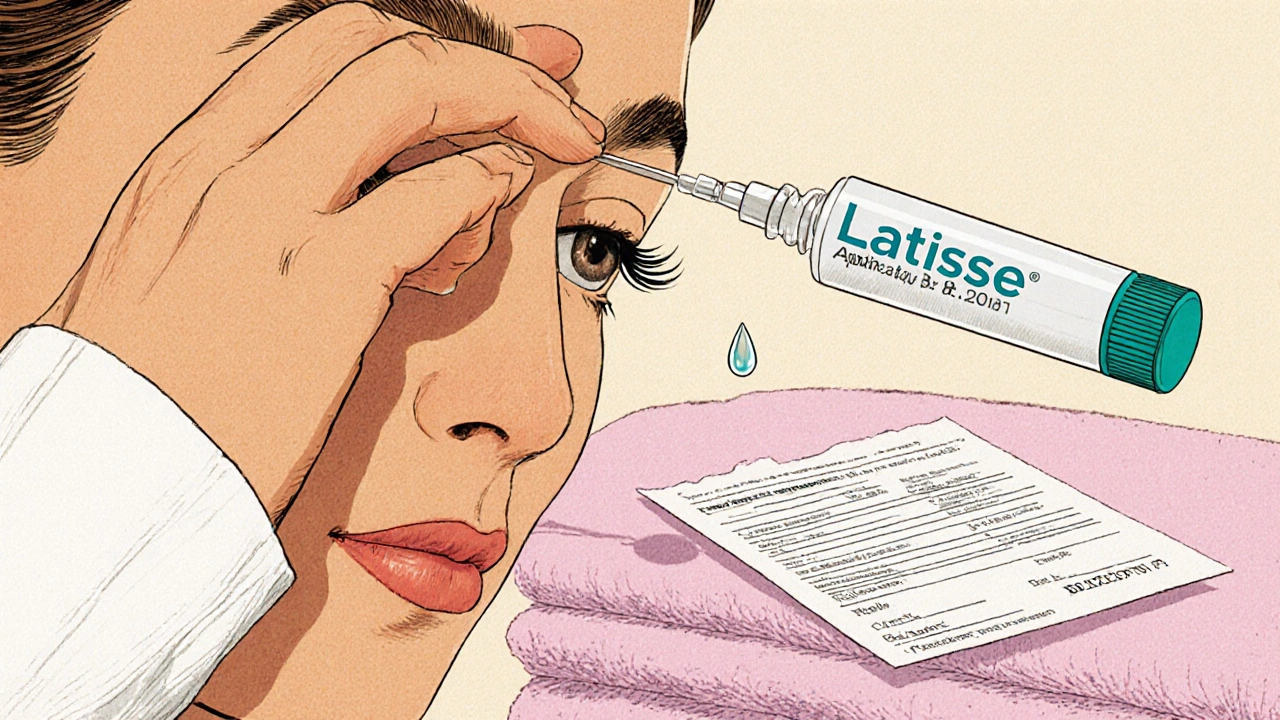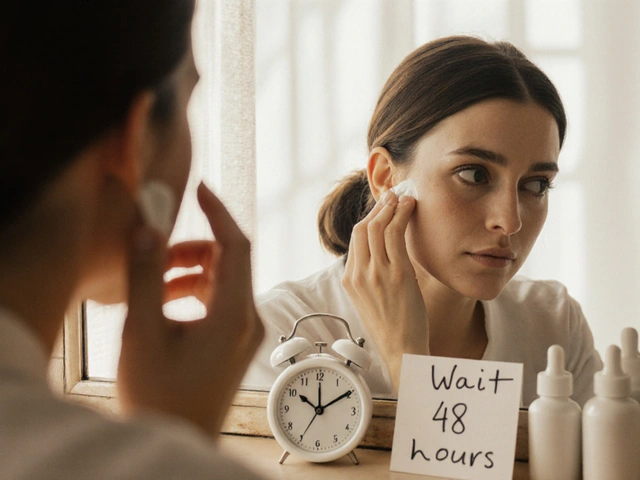Eyelash Growth Option Selector
Find the Right Eyelash Growth Option for You
Answer a few questions about your priorities and preferences to discover which eyelash growth product is best for your needs.
1. Prescription Access
2. Budget for 3-Month Supply
3. Risk Tolerance
4. When Do You Want to See Results?
5. Desired Enhancement Level
Your Personalized Recommendation
Cost:
Results timeline:
Why This Is the Best Option for You
When it comes to longer, fuller lashes, many people reach for prescription‑only drops, but the market is crowded with generics, off‑label eye drops, and over‑the‑counter serums. This guide breaks down Latisse (the brand name for Bimatoprost Ophthalmic Solution) and measures it against the most common alternatives, so you can pick the option that fits your goals, budget, and safety preferences.
Key Takeaways
- Latisse is the only FDA‑approved medication for eyelash growth, delivering clinically proven results in 8‑12 weeks.
- Generic bimatoprost offers similar efficacy at a lower price but may vary in formulation quality.
- Other prostaglandin analogs (travoprost, latanoprost) work off‑label with mixed results and a higher risk of side effects.
- Over‑the‑counter serums provide modest gains and are safest for sensitive eyes, but lack robust clinical data.
- Choosing the right product hinges on prescription access, cost tolerance, and how much risk you’re willing to accept.
What Is Latisse Ophthalmic Solution?
Latisse Ophthalmic Solution is a prescription‑only eye drop containing 0.03% bimatoprost, a synthetic prostaglandin analogue that stimulates hair follicles to extend the growth phase of eyelashes. It was cleared by the FDA in 2008 specifically for enhancing eyelash length, thickness, and darkness.
How Bimatoprost Works
Bimatoprost mirrors the action of natural prostaglandin F2α, binding to prostaglandin receptors on the hair follicle. This triggers a cascade of cellular signals that lengthen the anagen (growth) phase, allowing each lash to grow longer before it sheds. The effect is dose‑dependent-once‑daily application to the upper eyelid margin produces visible changes within two months.
Approved Use, Dosage, and Administration
- Apply one drop to the base of the upper eyelashes using the supplied sterile applicator.
- Repeat every night, preferably at the same time.
- Do not apply to the lower lashes; doing so increases the chance of irritation.
- Typical treatment cycles last 4-6 months; many users continue long‑term with periodic breaks.
Because it is a prescription medication, a qualified eye‑care professional must evaluate suitability, especially for patients with glaucoma or ocular hypertension.

Alternative Treatments Overview
Below are the most frequently mentioned options for people seeking longer lashes without the Latisse brand.
- Generic Bimatoprost - Identical active ingredient in a non‑brand formulation, often sold at a fraction of the cost.
- Travoprost Ophthalmic Solution - Another prostaglandin analogue approved for glaucoma; used off‑label for lashes.
- Latanoprost Ophthalmic Solution - Similar to travoprost, also approved for intra‑ocular pressure control and sometimes repurposed for lash growth.
- Off‑label Use of Other Glaucoma Drops - Some clinicians prescribe tafluprost or bimatoprost‑containing fixed‑dose combos.
- Over‑the‑Counter Lash Serums - Peptide‑based or plant‑extract formulas sold without prescription.
- Natural Remedies - Castor oil, vitamin E, and biotin supplements; anecdotal evidence only.
Comparison Table: Latisse and Its Alternatives
| Product | Active Ingredient | Prescription Status | Average Cost (USD per 5 ml) | Clinically Proven Efficacy | Main Side Effects |
|---|---|---|---|---|---|
| Latisse Ophthalmic Solution | Bimatoprost 0.03% | Prescription (FDA‑approved) | $120‑$150 | 86 % see ≥1 mm increase in length | Hypertrichosis, iris darkening, eye irritation |
| Generic Bimatoprost | Bimatoprost 0.03% | Prescription (same as brand) | $30‑$60 | 80‑85 % comparable to brand | Similar to brand; formulation variability |
| Travoprost Ophthalmic Solution | Travoprost 0.004% | Prescription (glaucoma) | $45‑$70 | ~60 % report modest growth | Iris discoloration, conjunctival hyperemia |
| Latanoprost Ophthalmic Solution | Latanoprost 0.005% | Prescription (glaucoma) | $40‑$65 | ~55 % see measurable lengthening | Iridial pigmentation, dry eye |
| OTC Lash Serum (peptide‑based) | Peptides, biotin, panthenol | Over‑the‑counter | $20‑$40 | ~20‑30 % notice subtle thickening | Minimal; occasional mild irritation |
Decision Criteria: Picking the Right Option
Not every eye‑drop works the same way, and your personal priorities shape the final choice. Use this quick checklist to narrow down the best fit.
- Prescription access: If you can see an optometrist, branded Latisse or a reputable generic gives the most predictable results.
- Budget constraints: Generic bimatoprost cuts costs dramatically; OTC serums are cheapest but less effective.
- Risk tolerance: Those wary of iris darkening or unwanted facial hair should stay with low‑risk OTC options.
- Desired speed of results: Latisse typically shows noticeable change by week 8; other prostaglandins may take longer.
- Regulatory confidence: FDA‑approval (Latisse, generic bimatoprost) offers the strongest safety data; off‑label use relies on clinician judgment.

Safety and Side‑Effect Considerations
All prostaglandin‑based drops share a common side‑effect profile because they act on the same receptors.
- Hypertrichosis: Unwanted hair growth can appear on the forehead, cheeks, or scalp.
- Iris discoloration: The brown or darker blue hue is permanent for the treated eye.
- Conjunctival hyperemia: Redness may be mild but can bother contact‑lens wearers.
- Dry eye or irritation: Use lubricating drops if needed, but avoid mixing products.
Patients with a history of glaucoma, ocular hypertension, or allergic eye disease should discuss risks with an ophthalmologist before starting any prostaglandin analog.
How to Obtain Latisse or Generics Safely
- Schedule a comprehensive eye exam with a licensed optometrist or ophthalmologist.
- Ask about eligibility for Latisse; the doctor will evaluate ocular health.
- If approved, the clinician can write a prescription that you fill at a reputable pharmacy (online or brick‑and‑mortar).
- For generics, verify the manufacturer’s reputation (e.g., Sandoz, Apotex) and ensure the product is FDA‑registered.
- Never purchase from unverified overseas websites; counterfeit drops can cause serious eye damage.
Frequently Asked Questions
Can I use Latisse if I have glaucoma?
Yes, but only under strict supervision. Bimatoprost can lower intra‑ocular pressure, which is beneficial for glaucoma, yet the dosing for lashes differs. Your eye doctor will balance the two needs.
How does the cost of generic bimatoprost compare to Latisse?
A 5 ml bottle of Latisse runs about $120‑$150 in the US, while a comparable generic typically costs $30‑$60, representing a 50‑80 % savings.
Do OTC lash serums work?
They can add a subtle density boost, but the results are far less dramatic than prescription prostaglandins. Expect 1‑2 mm growth at best after 3‑4 months.
Is iris darkening reversible?
No. Once the melanocytes in the iris have increased pigment, the change is permanent, even if you stop the drops.
Can I switch from Latisse to a generic without a break?
Yes, many clinicians advise a direct switch because the active ingredient is identical. Just confirm the new bottle’s concentration matches the brand (0.03%).
Whether you choose the FDA‑approved Latisse, a cost‑effective generic, or a milder over‑the‑counter serum, understanding the chemistry, efficacy data, and safety profile empowers you to make a confident decision. Keep this guide handy when you talk to your eye‑care professional - the right choice is the one that aligns with your expectations and health needs.






Comments
ram kumar
24/Oct/2025Ah, the age‑old quest for fluttering lashes, a modern vanity ritual wrapped in a pharmaceutical veneer. Latisse, with its glossy marketing, promises a miracle that feels almost mythic in its allure. Yet the very molecule that elongates those silk strands is a prostaglandin, a compound that meddles with ocular physiology. One cannot ignore the fact that users often awaken to a hazy iridescent browning of the iris, a permanent pigment shift that no amount of makeup can conceal. The hypertrichosis side‑effect, sprouting rogue hairs on the forehead, is not a whimsical bonus but a reminder of systemic influence. When you compare the sleek $130 price tag of the brand name to a generic offering at a fraction of the cost, the economic disparity becomes almost criminal. Banks of studies, albeit limited, still show a marginally higher efficacy for the brand, a difference that may be swallowed by the placebo of luxury. The FDA’s seal of approval, while reassuring, does not magically erase the need for vigilant ophthalmic supervision. Patients with glaucoma are handed a double‑edged sword, for bimatoprost can both lower intra‑ocular pressure and, paradoxically, trigger undesirable ocular changes. Moreover, the requirement of nightly application turns what could be a passive routine into a ritualistic chore, demanding patience for eight to twelve weeks before any visual payoff. If you are the type to obsess over every millimeter, you will rejoice at the 1‑2 mm incremental growth cited in trials. Conversely, the occasional faint redness or dry eye sensation, though mild, can become a daily nuisance for contact‑lens wearers. One must also ponder the ethical quagmire of sourcing such drops from shady online vendors, a pathway riddled with counterfeit dangers. The allure of a longer lash should never eclipse the paramount importance of ocular health, a fact many beauty‑obsessed forums neglect. In the grand tapestry of cosmetic enhancement, Latisse occupies a glittering but perilous niche, demanding both reverence and caution. Thus, before you surrender a portion of your budget and ocular serenity, weigh the shimmering promise against the lingering shadows of side‑effects.
Ken Dany Poquiz Bocanegra
24/Oct/2025Cost is often the decisive factor for many users; generic bimatoprost typically runs between $30 and $60 per bottle, a stark contrast to Latisse’s $120‑$150 price range. Both deliver comparable results, making the generic a pragmatic choice for budget‑conscious consumers.
Tamara Schäfer
24/Oct/2025I think yuo made a good point about the price, but there are still some concerns. The generics can be defintely cheaper, yet some people say the quality can vary. It would be nice if doctors reccomend a brand they trust, so you dont end up with a bad batch.
Tamara Tioran-Harrison
24/Oct/2025Evidently, the only thing more pretentious than a $150 eye drop is the audacity to claim it will transform your visage into a masterpiece.
One might as well purchase a small sculpture of a peacock and expect it to sing. :-)
kevin burton
24/Oct/2025The price gap between brand and generic is undeniably huge.
Max Lilleyman
24/Oct/2025😊 Surely, you’d rather spend on a drop than on actual talent, but the data doesn’t lie: efficacy correlates with concentration, not ego.
Brett Witcher
24/Oct/2025From a regulatory standpoint, Latisse holds the singular distinction of FDA approval for eyelash enhancement, a status that generic equivalents lack despite sharing the identical active ingredient. This approval ensures rigorous clinical validation of both efficacy and safety, a factor that discerning clinicians weigh heavily. Consequently, while the pharmacodynamics are indistinguishable, the brand’s manufacturing standards provide an additional layer of confidence.
Benjamin Sequeira benavente
24/Oct/2025Listen, the difference isn’t mystical – it’s about quality control; if you demand consistent results, push for the brand or at least a reputable compounding pharmacy! Don’t settle for sub‑par drops that could jeopardize your ocular health.
Shannon Stoneburgh
24/Oct/2025The side‑effects, especially iris darkening, remain irreversible, a fact many overlook in the hype. Proceed with caution.
Nathan Comstock
24/Oct/2025Allow me to elucidate the deeper pharmacological nuance you brushed aside: bimatoprost’s affinity for the FP receptor not only elongates lashes but also modulates melanin synthesis, accounting for the iris pigmentation you mentioned. This mechanism is not an incidental blemish but a predictable pharmacodynamic outcome, well‑documented across ophthalmic literature. Thus, any claim that it merely "adds length" without addressing the systemic cascade is a gross oversimplification. In short, the therapeutic benefit is inseparable from its side‑effect profile, and informed consent should reflect that complexity.